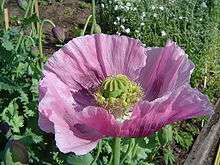Ethnomedicine
| Part of a series on |
| Medical and psychological anthropology |
|---|
|
Basic concepts |
|
Case studies |
|
Related articles |
|
Major theorists
|
|
Journals
|
| Social and cultural anthropology |
Ethnomedicine is a study or comparison of the traditional medicine practiced by various ethnic groups, and especially by indigenous peoples. The word ethnomedicine is sometimes used as a synonym for traditional medicine.
Ethnomedical research is interdisciplinary; in its study of traditional medicines, it applies the methods of ethnobotany and medical anthropology. Often, the medicine traditions it studies are preserved only by oral tradition.[1]
Scientific ethnomedical studies constitute either anthropological research or drug discovery research. Anthropological studies examine the cultural perception and context of a traditional medicine. The purpose of drug discovery research is to identify and develop a marketable pharmaceutical product.
Ethnopharmacology

Ethnopharmacology (occasionally also called ethnopharmacy) is a related study of ethnic groups and their use of drugs. It is distinctly linked to medicinal plant use, ethnobotany, as this is the main delivery of pharmaceuticals.[2] It is the interdisciplinary science that investigates the perception and use of pharmaceuticals within a given human society. Emphasis has long been on traditional medicines, although the approach also has proven useful to the study of modern pharmaceuticals.[3][4]
It deals with the study of the pharmaceutical means considered in relation to the cultural contexts of their use, e.g. the study of the cultural determinants that characterise the uses of these means within a culture. It involves studies of the:
- identification and ethnotaxonomy (cognitive categorisation) of the (eventual) natural material, from which the remedy will be produced (medical ethnobiology: ethnobotany or ethnomycology or ethnozoology);
- traditional preparation of the pharmaceutical forms (ethnopharmaceutics);
- bio-evaluation of the pharmacological action of such preparations (ethnopharmacology);
- their clinical effectiveness (clinical ethnopharmacy);
- socio-medical aspects implied in the uses of these pharmaceuticals (medical anthropology/ethnomedicine).
- public health and pharmacy practice-related issues concerning the public use and/or the re-evaluation of these drugs.
Ethnopharmacology shares a common terrain with medical anthropology and anthropology of pharmaceuticals. Ethnopharmacology also relates to pharmacoepidemiology, the study of how drugs are used by and affect large numbers of people. Ethnopharmacology is also strongly linked to food science,[5] since dietary modifications are traditionally used as a tool to modify health and disease conditions, and many plant species are traditionally used both as food and for medicinal purposes.
When investigating a natural product used by a culture as a medicine, it is important that the methods of collection, extraction and preparation are the same or similar to those used by the ethnic group. This is to ensure consistency and legitimacy of the experimentation.
See also
References
- ↑ Acharya, Deepak and Shrivastava Anshu: Indigenous Herbal Medicines: Tribal Formulations and Traditional Herbal Practices. Aavishkar Publishers Distributor, Jaipur / India 2008, ISBN 978-81-7910-252-7, p. 440.
- ↑ Thomas M. Johnson; Carolyn F. Sargent (1996). "Ethnopharmacology: The Conjunction of Medical Ethnography and the Biology of Therapeutic Action". Medical Anthropology: Contemporary Theory and Method. Westport, Connecticut: Praeger Publishers. pp. 132–133, 151.
- ↑ Buer, Jonas Kure. 2015. "A history of the term “DMARD”." Inflammopharmacology 23 (4):163-171. doi: 10.1007/s10787-015-0232-5.
- ↑ Buer JK (Oct 2014). "Origins and impact of the term 'NSAID'". Inflammopharmacology. 22 (5): 263–7. doi:10.1007/s10787-014-0211-2. PMID 25064056.
- ↑ Yeung AWK, Heinrich M, Atanasov AG. Ethnopharmacology-A Bibliometric Analysis of a Field of Research Meandering Between Medicine and Food Science? Front Pharmacol. 2018 Mar 15;9:215. doi: 10.3389/fphar.2018.00215.
Further reading
- Lee, Roberta; Balick, Michael J. (2001). "Ethnomedicine: Ancient Wisdom for Contemporary Healing" (PDF). Alternative Therapies in Health and Medicine. 7 (3): 28–30. Retrieved 12 June 2013.
- Fábrega, Horacio, Jr. Evolution of Sickness and Healing. Berkeley: University of California Press, 1997. Access apr. 2015
- Willem, Jean-Pierre (2006). L'Ethnomédecine, une alliance entre science et tradition [Ethnomedicine: An Alliance Between Science and Tradition] (in French). Paris: Jouvence & Biocontact. ISBN 2-88353-472-1.
- Willem, Jean-Pierre (2009). Mémoires d'un médecin aux pieds nus [Memoires of a Barefoot Doctor] (in French). Paris: Éditions Albin Michel. ISBN 978-2-226-18987-5.
